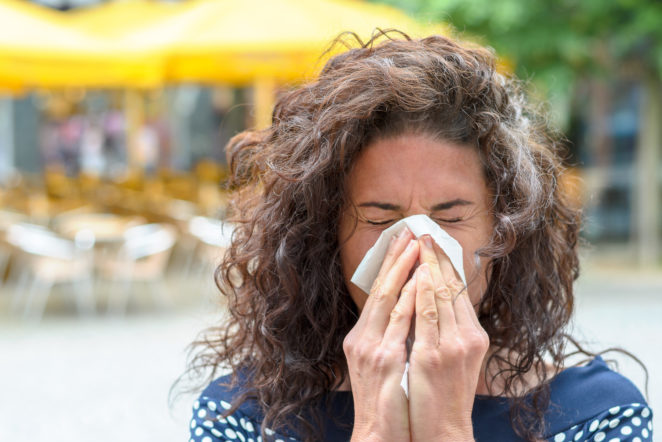Fall means cooler temperatures along with the start of school, sports, busy schedules and health insurance open enrollment. It also means the start of flu season. With COVID-19 still a serious concern, knowing how to decipher between the two different illnesses is important.
According to the Centers for Disease Control and Prevention (CDC), Influenza (Flu) and COVID-19 are both contagious respiratory illnesses, but they are caused by different viruses. COVID-19 is caused by infection with a new coronavirus (called SARS-CoV-2) and flu is caused by infection with influenza viruses. Because some of the symptoms of flu and COVID-19 are similar, it may be hard to tell the difference between them based on symptoms alone, and testing may be needed to help confirm a diagnosis. Flu and COVID-19 share many characteristics, but there are some key differences between the two.
Signs and Symptoms of COVID-19 and the Flu
Similar
Both COVID-19 and flu can have varying degrees of signs and symptoms, ranging from no symptoms (asymptomatic) to severe symptoms. Common symptoms that COVID-19 and flu share include:
- Fever or feeling feverish/chills
- Cough
- Shortness of breath or difficulty breathing
- Fatigue (tiredness)
- Sore throat
- Runny or stuffy nose
- Muscle pain or body aches
- Headache
- Some people may have vomiting and diarrhea, though this is more common in children than adults
Different
- Flu: Flu viruses can cause mild to severe illness, including common signs and flu symptoms listed above.
- COVID-19: Other signs and COVID-19 Symptoms, different from flu, may include change in or loss of taste or smell.
When Symptoms First Appear for COVID-19 and the Flu
Similar
For both COVID-19 and flu, one or more days can pass between a person becoming infected and when he or she starts to experience illness symptoms.
Different
If a person has COVID-19, it could take them longer to develop symptoms than if they had flu.
- Flu: Typically, a person develops symptoms anywhere from one to four days after infection.
- COVID-19: Typically, a person develops symptoms five days after being infected, but symptoms can appear as early as two days after infection or as late as 14 days after infection, and the time range can vary.
How Long A Person Is Contagious with COVID-19 and the Flu
Similar
For both COVID-19 and flu, it’s possible to spread the virus for at least one day before experiencing any symptoms.
Different
If a person has COVID-19, they may be contagious for a longer period of time than if they had flu.
- Flu: Most people with flu are contagious for about 1 day before they show symptoms. Older children and adults with flu appear to be most contagious during the initial three to four days of their illness but many remain contagious for about seven days. Infants and people with weakened immune systems can be contagious for even longer.
- COVID-19: How long someone can spread the virus that causes COVID-19 is still under investigation by the CDC. It’s possible for people to spread the virus for about two days before experiencing signs or symptoms and remain contagious for at least 10 days after signs or symptoms first appeared. If someone is asymptomatic or their symptoms go away, it’s possible to remain contagious for at least 10 days after testing positive for COVID-19.
How COVID-19 and the Flu Spread
Similar
Both COVID-19 and flu can spread from person-to-person, between people who are in close contact with one another (within about six feet). Both are spread mainly by droplets made when people with the illness (COVID-19 or flu) cough, sneeze or talk.
It may be possible that a person can get infected by physical human contact (e.g. shaking hands) or by touching a surface or object that has virus on it and then touching his or her own mouth, nose, or possibly their eyes.
Both flu virus and the virus that causes COVID-19 may be spread to others by people before they begin showing symptoms, with very mild symptoms or who never developed symptoms (asymptomatic).
Different
While COVID-19 and flu viruses are thought to spread in similar ways, COVID-19 is more contagious among certain populations and age groups than flu. Also, COVID-19 has been observed to have more superspreading events than flu. This means the virus that causes COVID-19 can quickly and easily spread to a lot of people and result in continuous spreading among people as time progresses.
Learn more about how flu spreads and how COVID-19 spreads.
Who is High Risk for COVID-19 and the Flu?
Similar
Both COVID-19 and flu illness can result in severe illness and complications. Those at highest risk include:
- Older adults
- People with certain underlying medical conditions
- Pregnant women
Different
According to the CDC, the risk of complications for healthy children is higher for flu compared to COVID-19. However, infants and children with underlying medical conditions are at increased risk for both flu and COVID-19.
- Flu: Young children are at higher risk of severe illness from flu.
- COVID-19: School-aged children infected with COVID-19 are at higher risk of Multisystem Inflammatory Syndrome in Children (MIS-C), a rare but severe complication of COVID-19.
Complications of COVID-19 and the Flu
Similar
Both COVID-19 and flu can result in complications, including:
- Pneumonia
- Respiratory failure
- Acute respiratory distress syndrome (i.e. fluid in lungs)
- Sepsis
- Cardiac injury (e.g. heart attacks and stroke)
- Multiple-organ failure (respiratory failure, kidney failure, shock)
- Worsening of chronic medical conditions (involving the lungs, heart, nervous system or diabetes)
- Inflammation of the heart, brain or muscle tissues
- Secondary bacterial infections (i.e. infections that occur in people who have already been infected with flu or COVID-19)
Different
- Flu: Most people who get flu will recover in a few days to less than two weeks, but some people will develop complications. Some of these complications are listed above.
- COVID-19: Additional complications associated with COVID-19 can include:
- Blood clots in the veins and arteries of the lungs, heart, legs or brain
- Multisystem Inflammatory Syndrome in Children (MIS-C)
- Learn more about COVID-19 Emergency warning signs
Treatment Options for COVID-19 and the Flu
Similar
People at high-risk of complications or who have been hospitalized for COVID-19 or flu should get medical care to help relieve symptoms and complications.
Different
- Flu: Prescription influenza antiviral drugs are FDA-approved to treat flu. People who are hospitalized with flu or at high-risk of flu complications with flu symptoms are recommended to be treated with antiviral drugs as soon as possible.
- COVID-19: The National Institutes of Health (NIH) has developed guidance on treatment of COVID-19, which will be regularly updated as new evidence on treatment options is available. While remdesivir is an antiviral agent that is being explored as a treatment for COVID-19 and is available under an Emergency Use Authorization (EUA), there are currently no drugs or other therapeutics approved by the Food and Drug Administration (FDA) to prevent or treat COVID-19. Studies are in progress to learn more.
Vaccines for COVID-19 and the Flu
Similar
Vaccines for COVID-19 and flu must be approved or authorized for emergency use (EUA) by the FDA.
Different
- Flu: There are multiple FDA-licensed influenza vaccines produced every year to protect against the three or four flu viruses that scientists anticipate will circulate each year.
- COVID-19: Currently, there is no approved vaccine to prevent COVID-19. Vaccine developers and other researchers and manufacturers are expediting the development of a vaccine to prevent COVID-19. For now, the best prevention remains social distancing, washing hands, sanitizing, wearing masks and more. Learn more here.
Get Your Flu Shot
Since flu vaccines are available, the CDC and health experts are strongly encouraging everyone to get their flu shot this season to help avoid a surge in both flu and COVID-19 cases—especially for seniors 65 or older. Learn more about common flu myths and facts here.
Still unsure if you should get a flu shot this season? It’s best to ask your doctor or another certified health provider. And before you pay full price for your flu shot at a clinic or retail location, be sure to check with your health insurance provider. Most plans offer flu shots as a preventive benefit at little to no cost when you go to an in-network location. Several clinics and health systems are offering drive-thru or curbside flu shot options this year due to COVID-19. Check the state’s flu vaccine directory here or ask your primary care provider.
Remember that a vaccination helps you fight getting more severe flu symptoms, but even after a flu shot you can still experience some minor flu symptoms. Hopefully it doesn’t happen, but here are some tips to help just in case.
In addition to getting your flu shot, it’s a good idea to stock up on prevention supplies like soap, hand sanitizer and extra masks so you can life your healthiest this fall and winter.
Wondering about the difference between COVID-19 and allergy symptoms? Learn more here.




